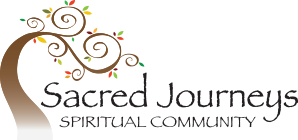
Passage of Awareness
We began a series on Easter Passages to try to discover the spiritual path the disciples took from “Easter” to Pentecost when they were finally ready to receive the power of the Holy Spirit and become his witnesses.
Two weeks ago we talked about those life events that drain us of our energy – emotional, physical and spiritual energy – and how our best course of action is not to push through, but to stand still (if at all possible)… to wait until we are renewed, regenerated, until we’ve had time to process or grieve or contemplate and are in a place to receive the power of the Spirit and more forward again.
So, the disciples are in that in-between space of waiting and I have to believe they were questioning who they were now. Now that their teacher and fearless leader was gone from their everyday midst.
Have you ever found yourself in that in-between space wondering who you were now? Now that you lost a parent, spouse or child. Now that you are separated or divorced. Now that you have graduated, gotten married, had a child, moved a child out, retired, lost a job. All of these times and more feel so terribly uncomfortable and uncertain. They are times of adjustment and transition. To have the courage to ask the question who am I now? is an important spiritual step if we’re willing to take it.
This time is a passage of awareness. We get a glimpse of it in Jesus’ appearance to the disciples on the shore of Lake Tiberias (otherwise known as the Sea of Galilee) in John 21. Two weeks ago we left the disciples with their instructions to wait for that unpredictable Holy Spirit to show up. As we all know, waiting can be stressful and monotonous. Seems like Peter finally had enough. “I’m going fishing,” he said. And the other guys all jumped on the suggestion. It was who they used to be, it was something familiar, a good distraction, something they could do, something that would feed them, something that would give them some space to think and just be.
It's telling that in the story they caught nothing without Jesus. All night their nets were empty. How frustrating. Perhaps this was a way of saying you can’t really go back. They couldn’t do what they used to do with any kind of success until Jesus showed up, told them to cast the net off the other side of the boat and they hauled in 153 fish.
The disciple whom Jesus loved was the first to identify Jesus because of this miraculous catch. Peter! It’s the Teacher! Peter is so excited that he throws on his cloak and jumps in the water and swims to shore.
I find myself wondering what Jesus looked like, because he clearly didn’t look like, or maybe even sound like, himself. It wasn’t until they hauled in all those fish that one of the disciples knew for sure who it was. And then after they’d gone ashore Jesus said to them, “come and eat.” And it says none of them dared ask “Who are you?” they knew it was Jesus. But why would “daring to ask” even be a thing unless he didn’t look the same?
Sue Monk Kidd, in When the Heart Waits, talks about her own growing awareness of her soul, not as something to save, but as “the seat and repository of the inner Divine, the God-image, the truest part of us.”
What if, in Jesus’ death and subsequent appearance, he looked different because he was now that much closer in union with the Divine? What if, in these appearances, the disciples recognize that there is more to each of us than what meets the eye? What if they begin to understand more deeply that our spiritual journeys are about shedding the layers of life and experiences that mask our souls so that we may, in Sue Monk Kidd’s words, “green” our souls, and “develop the divine seed that wait realization” within us, to work on “an honest dialogue with the uniqueness of one’s soul and finding a deeply personal relationship with God, the inner Voice, the inner Music that plays in you as it does in no one else.”
To achieve this passage of awareness we need to ask ourselves, what are the layers we’ve piled up over our souls? What masks do we hide behind because they keep us from being vulnerable? Let me give you an example. My wife, Julie, has said to me a few times that when I’m with her family she wants me to just be myself and not hold back so much. At best, I imagine I come off as reserved, shy, and quiet or, at worst, as standoffish. Someone else tangentially associated with Sacred Journeys commented recently that “you’re a pretty private person, aren’t you?” I didn’t intend to become this way, but being a pastor has dictated that I should do more asking than answering of questions (at least personal ones). And, I’ve been burned pretty good by a few people I trusted and that has caused me to pull back under my pastor shell to stay safe, much like a turtle only allows so much of itself to others.
There are many mask, shells and layers we hide under including intelligence, humor, toughness, aloofness, roles, anger, judgments, being a victim or a pleaser or whatever others want you to be.
I understand that it is normal and not necessarily “bad” to wear these roles or masks at certain times. But we can do it so unwittingly that we think we ARE those layers and forget that there is more underneath. The passage of awareness reminds us of who we are deep within and helps us see clearly what we use to cover that up and keep that safe. Once we have some awareness, then we need to choose whether or not to come out of our shells a little more and be more vulnerable. But keep in mind that he spiritual journey is a continual peeling back of these layers and masks that hide our deepest selves.
Ram Dass has been widely acclaimed as a great spiritual teacher. His most popular book was called Be Here Now and was a mish-mash of Buddhist, Hindu and Christian spirituality. Yet, even he talks about a passage of awareness he went through.
In an excerpt from his book Still Here he talks about how he spent much of his adult life concentrating on the spiritual realm and keeping a distance from his body, so much so that he ignored it as much as possible and tried to “spiritualize it away.” He went so far as to neglect his body, not taking his blood pressure meds as he should have and ignoring strange symptoms like an unusual one-sided hearing loss that lasted for a time. He believes this likely contributed to the massive stroke he had in 1997 when he lost the ability to walk and speak.
He said, “Before the stroke, although I was in my 60’s, I saw myself as young and powerful, with my MG, golf clubs, surfing, and speaking gigs. Illness had shattered my self-image and opened the door to a new chapter in my life. After any major physical “insult,” as they call it, it’s all too easy to see yourself as a collection of symptoms rather than as a total human being, including your spirit — and thus to become your illness. Fear is powerful and contagious, and at first I allowed myself to catch it, worried that if I didn’t do what the doctors ordered, I’d be sorry.”
Do you see the masks here? He saw himself as young and powerful. And then he saw himself as his stroke.
Finally, he came to a point where he was able to see deeper, where he no longer identified himself as a stroke victim. He went through a passage of awareness. He said he took his “healing into [his] own hands. Healing is not the same as curing, after all; healing does not mean going back to the way things were before, but rather allowing what is not to move us closer to God.”
He almost gave up his speaking engagements altogether, since his speech was heavily impaired by the stroke. But people insisted that the slow, halting way he spoke enabled them to “concentrate on the silence between the words” and to come to answers for themselves.
Ram Dass wrote,
“We have to find another way to look at the whole process of being born, growing old, changing, and dying, some kind of perspective that might allow us to deal with what we perceive as big obstacles without having to be dragged through the drama. It really helps to understand that we have something — that we are something — which is unchangeable, beautiful, completely aware, and continues no matter what. Knowing this doesn’t solve everything… and I’ve still had my share of suffering. But the perspective of the soul can help a lot with the little things.”
In the book he shared how a friend had recently said to him, “You’re more human since the stroke than you were before.” He said that touched him deeply. What it says to me is that he was more approachable, more vulnerable, more in touch with life as we all go through it. The new perspective it gave him was not to be a “wise elder” but to be “an incarnation of wisdom.” He said, “That changes the whole nature of the game. That’s not just a new role; it’s a new state of being. It’s the real thing.”
Who am I? This question has been used as a Buddhist koan… a question to ask oneself over and over again to get past the easy answers and find the deeper self. It is the question I invite all of us to explore. May we have the awareness to identify the times we cover ourselves with layers, wear different masks or pull on our shells. May we seek to know more intimately the part of ourselves that is the soul, something more, something unchangeable and beautiful.
Love & Light!
Kaye



